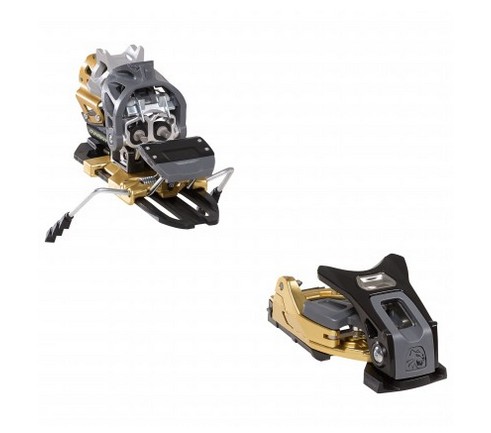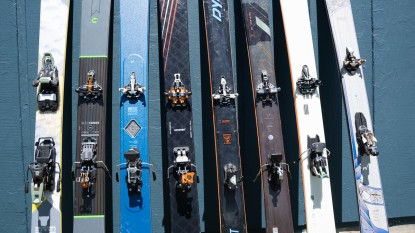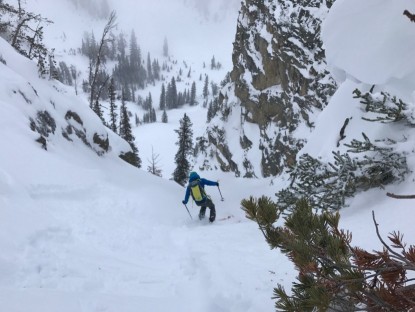Dynafit Beast 16 Review
Our Verdict
Our Analysis and Test Results
Ease of Use
Unlike nearly all other tech bindings, you can't just buy a tech compatible boot and use the Beast 16; you'll need to slightly modify the rear of the boot with an additional heel piece (this has to do with an ISO standard that refers to the heel radius of touring boots). Unscrew the existing stock piece of metal that is inserted in between the pin holes at the rear of the boot and replace it with the compatible version. While this isn't a super big deal to do, our testers agree it is a marginal pain. Boot modifications aside, other than offering easy-to-engage heel risers and simple step-in performance, this model is not one of the easier bindings to use. As a whole, they do offer a much higher fiddle factor than most other bindings.
Transitions
This contender is reasonably easy to get into: just flip open the toe piece and allow the towers to assist in lining up your boot's pin holes with the toe piece; apply a slight amount of pressure in order for the toe piece to engage and voila! For touring, simply keep the toe piece flipped forward, which will lock out the boot. This rotation is similar to a Dynafit Radical ST 2.0. Once the toe piece is locked out, flip over the lower heel riser. When pressured, it will flip up and lock the brake into touring position automatically and you'll be ready to start touring. This is a pretty sweet feature that certainly makes transitioning easier with the exception that it keeps the binding from sporting a completely flat touring mode. One cool feature is that it's the easiest of the burly bindings to step into and engage the heel piece. It's noticeably easier than the Marker Baron 13 EPF, Marker Duke, or Salomon Guardian 16.
Touring Performance
This model doesn't offer a completely flat-footed touring position; it offers almost flat foot touring and a single heel riser options. This alone knocked off several points from its touring performance score. On longer tours that forced us on a long flat or very mellow ascent, this model sapped energy from our legs by not allowing them to completely straighten out. This contender does offer the same super-efficient touring pivot point as all other tech bindings and has a far more efficient stride than a Marker Baron 13 EPF or Marker Duke.
Downhill Performance
This pair of bindings has good downhill performance; it provides incredible solid boot-to-binding and binding-to-ski energy transfer, binding elasticity, and fantastic and reliable retention and reliability. While the mass and moving parts of this model might be disadvantages, these bindings do offer superb energy transfer. We would easily recommend this pair of bindings to skiers who want to ski primarily in-bounds and we feel there is little disadvantage to this model when it comes to downhill performance, especially when compared to other downhill-focused touring bindings.
This competitor is likely the safest tech-style binding in our review. The two heel pins are engineered in such a fashion to offer a significant amount of movement; they allow for the user to be retained when the forces applied aren't great enough, but also enable the user to be released in even the most unusual and awkward falls. This model is also the only tech-style binding to go up to a 16 DIN release value.
One of the first things we noticed when we stepped into this model was how little play the binding had. After skiing it both in-bounds and out, we could feel how efficient the energy transfer was; it performed equally to the Marker Kingpin 13 and was possibly a smidgen better. It performed better on the down than the Fritschi Vipec EVO 12, G3 ION 12, and Dynafit Radical ST 2.0.
Durability
This is one burly binding, but there are a lot of moving parts. We haven't heard of too many issues. However, we expect that long-term will not score at the very top for durability.
Weight
This model tips the scales at 4 lbs 2 oz. This is almost a pound heavier than the similar Marker Kingpin 13 (3 lbs 4 oz), but still lighter than the 4 lb 13 oz Fritschi Freeride Pro, or the 5 lbs 12 oz Marker Baron 13 EPF.
Best Applications
This pair of bindings falls into a bit of a strange zone. While it does perform exceptionally well on the downhill, we would go with the Marker Duke or Baron if we were going to get a touring binding to be used primarily for in-bounds skiing and/or occasional touring. This contender does not tour as well as the Marker Kingpin 13 or the Dynafit Radical ST 2.0, as it's heavier and can not tour flat-footed. This model is best utilized by someone who is going to use their binding either by lift-accessed skiing or by other forms via mechanized assisted touring (sled, cat, heli accessed, etc), with occasional touring, and when they still want to utilize the more efficient pivot point of a tech binding.
Value and the Bottom Line
At $850, these are the most expensive bindings in our review. While they are a unique binding that performs very well on the downhill and tours uphill better than several frame style bindings, we wonder if they're worth the price tag. Should we shell out $200 more than the Marker Kingpin 13? That's a tough question; while this model might perform ever so slightly better on the down than the Kingpin, the Kingpin 13 does tour noticeable better.
Conclusion
This is a rad binding for the right type of user. They aren't the best touring binding, nor are they the best overall randonee binding for mostly in-bounds skiing and occasional touring. They hit the sweet spot for folks who want a tech-style binding for their occasional touring but want to minimize any decrease in downhill performance.






